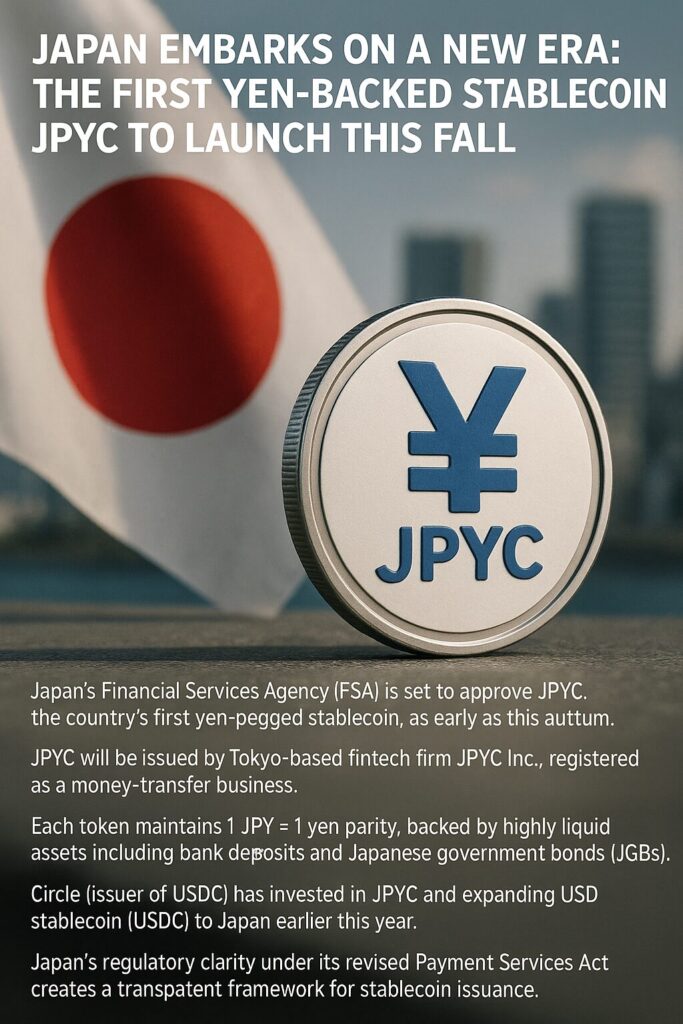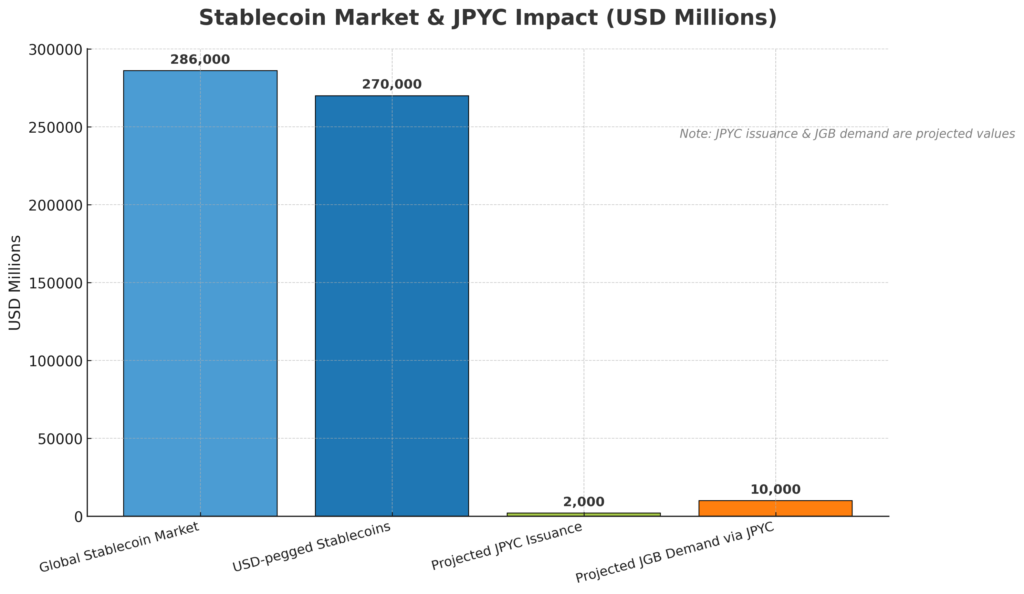
Main Points:
- Japan’s Financial Services Agency (FSA) is set to approve JPYC, the country’s first yen‑pegged stablecoin, as early as this autumn.
- JPYC will be issued by Tokyo‑based fintech firm JPYC Inc., registered as a money‑transfer business.
- Each token maintains 1 JPY = 1 yen parity, backed by highly liquid assets including bank deposits and Japanese government bonds (JGBs).
- This marks Japan’s inaugural domestic fiat‑pegged digital currency, entering a global stablecoin market dominated by dollar‑denominated assets, now exceeding US $286 billion.
- JPYC could become a major institutional buyer of JGBs, potentially reshaping bond market demand.
- Circle (issuer of USDC) has invested in JPYC and expanded USD stablecoin (USDC) to Japan earlier this year.
- Japan’s regulatory clarity under its revised Payment Services Act creates a transparent framework for stablecoin issuance.
- JPYC’s arrival could catalyze blockchain adoption for payments, remittances, DeFi, and digital asset innovation.
1. Regulatory Green Light: Approval of JPYC This Fall
Japan’s Financial Services Agency (FSA) is preparing to grant regulatory approval for the issuance of JPYC, the nation’s first yen‑pegged stablecoin, as early as this fall. JPYC Inc., a Tokyo‑based fintech venture, is poised to register as a money‑transfer service provider within the month, paving the way for the stablecoin’s formal launch.
2. How JPYC Works: Structure, Issuance, and Backing
Once issued, JPYC tokens will maintain a fixed 1 JPY = 1 yen peg, thanks to robust backing by highly liquid collateral—comprising bank deposits and Japanese government bonds (JGBs). Individuals and corporations can apply to purchase JPYC via bank transfer, and tokens will be issued directly into their digital wallets.
Under the amended Payment Services Act of 2023, stablecoin issuers must operate as regulated entities—banks, trust companies, or licensed money‑transfer services—ensuring a high standard of transparency and accountability . JPYC must fully collateralize issued tokens and adhere to strict liquidity management, including maintaining over‑collateralization and rapid reserve replenishment.
3. Japan’s Entry into the Global Stablecoin Arena
JPYC marks Japan’s first domestically‑issued fiat‑pegged digital currency, entering a global stablecoin ecosystem that is overwhelmingly dollar‑denominated. The global market size now exceeds US $286 billion . While dollar‑pegged stablecoins like Tether (USDT) and USDC have already penetrated the Japanese market, this is Japan’s first home‑grown stablecoin.
Earlier this year, Circle’s USDC launched in Japan after gaining FSA approval for listing on SBI VC Trade, marking the first foreign stablecoin cleared under Japan’s regulatory framework.
JPYC thus delivers a crucial domestic alternative, reducing reliance on foreign USD‑based digital currencies and reinforcing Japan’s financial sovereignty.
4. Potential Impact on Japan’s Government Bond Market
JPYC may emerge as a significant institutional buyer of Japanese government bonds (JGBs), analogous to how major US dollar‑stablecoin issuers buy US Treasuries as collateral. JPYC representative Okabe flagged this dynamic in a recent post, asserting that widespread adoption could escalate demand for JGBs, potentially lowering bond yields and inflecting monetary policy outcomes.
Countries that fall behind in stablecoin development may be denied access to this new institutional demand, possibly leading to higher bond interest rates.
5. Strategic Partner: Circle’s Investment and USDC Entry
Circle, the issuer of USDC, has made a strategic investment in JPYC through Series A funding, contributing to JPYC’s growth and development. JPYC reportedly raised around ¥500 million in total Series A funding, with Circle among the investors.
Earlier, Circle had expanded USDC into Japan via SBI VC Trade, following FSA clearance, enabling listing on major exchanges like Binance Japan, bitbank, and bitFlyer. This expansion underlines institutional confidence and intensifies competition and collaboration in Japan’s nascent stablecoin landscape.
6. Japan’s Regulatory Framework: A Model of Clarity
Japan’s revised Payment Services Act (2023) differentiates between types of stablecoins and mandates clear issuance pathways. Only banks, trust companies, or licensed money‑transfer services can issue fiat‑pegged stablecoins, with detailed requirements on reserves and redemption rights. This regulatory clarity positions Japan as a potential global model for stablecoin frameworks.
7. Broader Trends: Blockchain Use and Innovation
The launch of JPYC aligns with a growing domestic interest in leveraging blockchain for practical financial applications—including payments, cross‑border remittances, corporate finance, and potentially DeFi and tokenized securities. Japan’s embrace of regulated stablecoins could unlock innovation in digital asset infrastructure and consumption. (Insert Graph/Figure Here)

Conclusion
Japan’s approaching approval of JPYC—the first yen‑pegged stablecoin—marks a pivotal moment in global fiat‑digital finance. With strict regulatory oversight, transparent issuance standards, and backing by bank deposits and government bonds, JPYC offers a stable, domestic alternative to dollar‑based stablecoins. It could reshape Japan’s bond market through new institutional demand, catalyze blockchain adoption across financial segments, and elevate Japan as a model for digital currency regulation. Backed by strategic investment from Circle, and under a robust legal framework, JPYC stands poised to open a new chapter for yen‑based digital finance and innovation.

